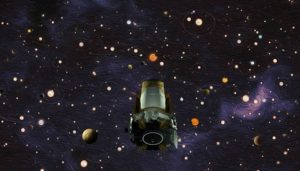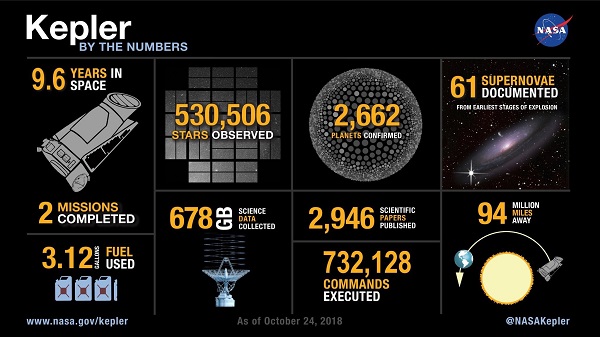NASA's planet-hunting telescope has run out of fuel after a nine-year mission that found more than 2,600 planets orbiting other stars along with thousands of candidate worlds.

NASA / Wendy Stenzel / Daniel Rutter
After a nine-year historic mission, the Kepler Space Telescope has finished its job. Exhausted of fuel and hobbled with inoperative reaction wheels, Kepler's exoplanet hunting days are over.
“As NASA's first planet-hunting mission, Kepler has wildly exceeded all our expectations and paved the way for our exploration and search for life in the solar system and beyond,” said Thomas Zurbuchen (NASA Headquarters) in an October 30th press release. “Not only did it show us how many planets could be out there, it sparked an entirely new and robust field of research that has taken the science community by storm.”
On the Hunt For Exoplanets
Launched atop a United Launch Alliance Delta II rocket on a spectacular night shot on March 8th, 2009 (Eastern Time), Kepler took up station in an Earth-trailing heliocentric orbit shortly afterwards.
The initial mission of the Kepler Space Telescope was to stare at a patch of sky along the plane of the Milky Way Galaxy overlapping the constellations of Lyra, Hercules, and Cygnus, looking for rhythmic dips in the light curves of stars that betray the presence of transiting planets as they passed in front of their host stars. To this end, Kepler monitored around 150,000 main sequence stars during its primary mission (530,506 stars overall during its entire career) and ultimately turned up 2,899 exoplanet candidates and 2,662 confirmed worlds.
Original plans called for a primary 3.5-year mission for the Kepler Space Telescope. Trouble first struck the Kepler on July 14th, 2012, when the first of four reaction wheels failed. Three reaction wheels are critical to Kepler, to keep it continuously aligned along three axes pointing at its assigned patch of sky. Then, Kepler lost a second reaction wheel on May 11th, 2013.
NASA soon came up with a solution: Kepler would use the gentle push of the solar wind as a third "stabilizer", enabling it to slowly scan a path along the ecliptic plane looking for transiting exoplanets. The extended K2 mission to hunt for additional exoplanets was soon underway.
NASA extended the Kepler mission in mid-2016 for another three years, to match the expected amount of fuel left in the spacecraft. NASA brought Kepler out of sleep mode in August 2018, though it soon had more problems with its aging thrusters. Critically low on fuel, the final death knell for Kepler came this week during Campaign 19. The last of Kepler's data will overlap with current ground- and space-based efforts to discover new transiting exoplanets.
Kepler's Legacy

NASA/Ames/Wendy Stenzel
To put the Kepler mission in context, less than 500 exoplanets were known of when Kepler first went into service. Kepler soon expanded that tally past 1,000 in 2013. Today, an amazing 3,874 worlds are known, two-thirds of which are thanks to Kepler. Expanding the inventory of known worlds beyond our solar system has allowed astronomers to start to characterize other worlds and solar systems. Data from Kepler are still being analyzed and will go a long ways towards telling us just how common (or rare) the Earth and our solar system really are.
Already, analysis of Kepler's data has provided us with striking insights. For example, Kepler's slew of discoveries suggest that about 20% to 50% of stars in the Milky Way have small, rocky Earth-sized planets located in the habitable zone of their host star and could maintain liquid water on their surface. Kepler also showed us that the most common sort of world — "super-Earths" bigger than our own planet but smaller than Neptune — aren't seen in our own solar system. Just what these transitional worlds between rocky terrestrial planets and ice giants are like remains to be seen.
Kepler has also revealed miniature solar systems, such as the eight planets in the Kepler-90 system orbiting a G-type main sequence star and the KOI-961 system orbiting around a red dwarf star. Both are examples of "mini-solar systems" that make our own solar system look relatively sparse in comparison.
The exoplanet hunting task is now passed on to the Transiting Exoplanet Survey Satellite (TESS) and the James Webb Space Telescope (JWST) set to launch in early 2021. TESS, in particular, is an exciting mission; launched in early 2018, TESS is also hunting for transiting exoplanets, but unlike Kepler, it will cover the entire sky during its survey. TESS is also expected to add exponentially to the known number of exoplanets.
“We know the spacecraft's retirement isn't the end of Kepler's discoveries,” said Jessie Dotson (NASA's Ames Research Center) in a recent press release. “I'm excited about the diverse discoveries that are yet to come from our data and how future missions will build upon Kepler's results.”
It's sobering to think: less than a quarter century ago, no exoplanets were known. Kepler will now slowly follow the Earth in its orbit around the Sun, a testament to the pioneering effort in modern astronomy to uncover worlds beyond our solar system.
 1
1









Comments
quantumfog
November 2, 2018 at 8:36 pm
I am very sad to hear of the end of the Kepler mission. I have always felt that its contribution to the knowledge of our place in the universe is perhaps the most important science that has ever been done. There has been a huge gain in our understanding of the universe since the Renaissance, but determining the probability of life outside our solar system has remained almost an entirely unknown quantity until Kepler. It is amazing to me that in my lifetime we have started to take the first basic steps in answering that question.
And the solar wind idea for K2. I don't know who came up with that concept, but you folks are amazing.
Congratulations to all the scientists, engineers, and mission planners at NASA for such an outstanding success!
You must be logged in to post a comment.
You must be logged in to post a comment.